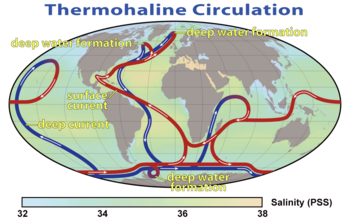
Back Termohaliene sirkulasie AF دورة حرارية ملحية Arabic Circulación termohalina AST Тэрмахалінная цыркуляцыя BE Circulació termohalina Catalan Termohalinní výměník Czech Den termohaline cirkulation Danish Thermohaline Zirkulation German Θερμόαλη κυκλοφορία Greek Oceana transportbendo EO

Thermohaline circulation (THC) is a part of the large-scale ocean circulation that is driven by global density gradients created by surface heat and freshwater fluxes.[1][2] The adjective thermohaline derives from thermo- referring to temperature and -haline referring to salt content, factors which together determine the density of sea water. Wind-driven surface currents (such as the Gulf Stream) travel polewards from the equatorial Atlantic Ocean, cooling en route, and eventually sinking at high latitudes (forming North Atlantic Deep Water). This dense water then flows into the ocean basins.[3] While the bulk of it upwells in the Southern Ocean, the oldest waters (with a transit time of about 1000 years) upwell in the North Pacific.[4] Extensive mixing therefore takes place between the ocean basins, reducing differences between them and making the Earth's oceans a global system.[3] The water in these circuits transport both energy (in the form of heat) and mass (dissolved solids and gases) around the globe. As such, the state of the circulation has a large impact on the climate of the Earth.
The thermohaline circulation is sometimes called the ocean conveyor belt, the great ocean conveyor, or the global conveyor belt, coined by climate scientist Wallace Smith Broecker.[5][6] It is also referred to as the meridional overturning circulation, or MOC. This name is used because not every circulation pattern caused by temperature and salinity gradients is necessarily part of a single global circulation. Further, it is difficult to separate the parts of the circulation driven by temperature and salinity alone from those driven by other factors, such as the wind and tidal forces.[7]
This global circulation has two major limbs - Atlantic meridional overturning circulation (AMOC), centered in the north Atlantic Ocean, and Southern Ocean overturning circulation or Southern Ocean meridional circulation (SMOC), around Antarctica. Because 90% of the human population lives in the Northern Hemisphere,[8] the AMOC has been far better studied, but both are very important for the global climate. Both of them also appear to be slowing down due to climate change, as the melting of the ice sheets dilutes salty flows such as the Antarctic bottom water.[9][10] Either one could outright collapse to a much weaker state, which would be an example of tipping points in the climate system. The hemisphere which experiences the collapse of its circulation would experience less precipitation and become drier, while the other hemisphere would become wetter. Marine ecosystems are also likely to receive fewer nutrients and experience greater ocean deoxygenation. In the Northern Hemisphere, AMOC's collapse would also substantially lower the temperatures in many European countries, while the east coast of North America would experience accelerated sea level rise. The collapse of either circulation is generally believed to be more than a century away and may only occur under high warming, but there is a lot of uncertainty about these projections.[10][11]
- ^ Cite error: The named reference
Rahmstorf2003was invoked but never defined (see the help page). - ^ Lappo, SS (1984). "On reason of the northward heat advection across the Equator in the South Pacific and Atlantic ocean". Study of Ocean and Atmosphere Interaction Processes. Moscow Department of Gidrometeoizdat (in Mandarin): 125–9.
- ^ a b "What is the global ocean conveyor belt?". NOAA. Archived from the original on 31 December 2017.
- ^ Primeau, F (2005). "Characterizing transport between the surface mixed layer and the ocean interior with a forward and adjoint global ocean transport model" (PDF). Journal of Physical Oceanography. 35 (4): 545–64. Bibcode:2005JPO....35..545P. doi:10.1175/JPO2699.1. S2CID 130736022.
- ^ Schwartz, John (20 February 2019). "Wallace Broecker, 87, Dies; Sounded Early Warning on Climate Change". The New York Times. ISSN 0362-4331. Retrieved 5 June 2022.
- ^ de Menocal, Peter (26 March 2019). "Wallace Smith Broecker (1931–2019)". Nature. 568 (7750): 34. Bibcode:2019Natur.568...34D. doi:10.1038/d41586-019-00993-2. S2CID 186242350.
- ^ Wunsch, C (2002). "What is the thermohaline circulation?". Science. 298 (5596): 1179–81. doi:10.1126/science.1079329. PMID 12424356. S2CID 129518576.
- ^ Collins, Kevin (3 November 2023). "El Niño may be drying out the southern hemisphere – here's how that affects the whole planet". The Conversation.
- ^ "NOAA Scientists Detect a Reshaping of the Meridional Overturning Circulation in the Southern Ocean". NOAA. 29 March 2023.
- ^ a b Lenton, T. M.; Armstrong McKay, D.I.; Loriani, S.; Abrams, J.F.; Lade, S.J.; Donges, J.F.; Milkoreit, M.; Powell, T.; Smith, S.R.; Zimm, C.; Buxton, J.E.; Daube, Bruce C.; Krummel, Paul B.; Loh, Zoë; Luijkx, Ingrid T. (2023). The Global Tipping Points Report 2023 (Report). University of Exeter.
- ^ Logan, Tyne (29 March 2023). "Landmark study projects 'dramatic' changes to Southern Ocean by 2050". ABC News.